Published Date: November 23th, 2024
SPECIAL REPORT
TRUTH///AWAKENING///DISCLOSURE
2024 THANKSGIVING EDITION
A Heartfelt Thanksgiving Greeting to Family & Friends:
Thanksgiving Edition Featured Topics
• Tracing Traditions | The Origins of Thanksgiving
• From Past to Present | The Journey of Thanksgiving Celebrations
• Harmony Of Traditions | Cultural Influences and Time-Honored Customs
• Thanksgiving Myths | Unpacking the Legends and Misconceptions
• Thanksgiving Cinema | Movies and Shows to Celebrate the Holiday
• Thanksgiving in Sight and Sound | Songs, Hymns, and Enchanting Visuals
• A World of Thanks | Exploring Thanksgiving Across Cultures
• The Heart of Thanksgiving | How Faith Fuels a Life of Gratitude
• Thanksgiving With Family and Friends | Strengthening Community Bonds
• Mending Hearts | The Transformative Spirit of Thanksgiving Giving
• Homeward Bound | Weathering the Thanksgiving Travel Experience
• The Culinary Delights of Thanksgiving | A Feast for the Senses
• Elevating Thanksgiving Dinner | Healthy Substitutes for Timeless Classics
• Creating a Cozy Thanksgiving Home | Decor Ideas to Welcome Family and Friends
• Thanksgiving, Mindfulness and Gratitude: Finding the Divine in Daily Life
• The Power of Prayerful Thanks | Expressing Thanks Through Rituals and Prayer
• Exploring Spiritual Perspectives | The Transformative Power of Gratitude
• Thanksgiving Reflections | Insights from Spiritual Teachers
• Embracing Gratitude | A Spiritual Journey on Thanksgiving
• Quotes Of Thanks | Celebrating Thanksgiving Through Inspirational Words

Celebrating Thanksgiving Then and Now
Remembrances of holidays past can enable us to appreciate the present.
On Oct. 3, 1789, America’s new president, George Washington, designated the last Thursday in November of that year a day of “public thanks-giving” for the new republic and its Constitution. However, the concept didn’t stick.
Sarah Hale, author of “Mary Had a Little Lamb,” had labored for years to make Thanksgiving a national event. Finally, in 1863, in the middle of the Civil War, President Abraham Lincoln revived President Washington’s day of gratitude. This time, the idea stuck.
In 1901, President Theodore Roosevelt made November’s fourth Thursday an official national holiday intended “to thank the Giver of all good for our national blessings.” In 1939, to extend the holiday shopping season so as to help battle the ongoing Depression, President Franklin D. Roosevelt moved Thanksgiving to a week earlier. This shift of dates met with resistance, and in 1941, he signed a bill officially declaring the fourth Thursday of November as Thanksgiving Day.
Thanksgiving today remains centered on gratitude, family, and food, yet there were moments in our history when circumstance and custom shaped this holiday in unusual ways. Here are some memories from the past that might enlighten and enliven our own celebrations this year.
Good Times
At the beginning of the 20th century, American pride and confidence in itself were at a peak, and the lavish Thanksgiving dinners of the wealthy reflected the country’s abundance. The 1900 “Thanksgiving Dinner” menu for New York’s Park Avenue Hotel offered patrons their choice of such foods as oysters, creamed fresh mushrooms on toast, boiled Kennebec salmon, saddle of lamb with kidney beans, potted quail, diamondback terrapin, Rhode Island turkey, ribs of prime beef, and much more, including a sizable array of vegetables, potato dishes, desserts, candies, cheese, nuts, rum, and coffee.
Meanwhile, that same year, Good Housekeeping magazine offered its subscribers a menu more in keeping within the means of a middle-class American family of the time, with fare more familiar to us today: cranberry sauce, turkey, mashed potatoes, and pumpkin pie. By then, clearly, these foods had become as much a part of Thanksgiving as they are today.
President Theodore Roosevelt was in the White House, and two Thanksgiving stories from his presidency tell us a little about the man and his times. In 1902, carpenters and painters were pushing to finish work on the White House’s West Wing. When the president learned that these men were laboring away on Thanksgiving Day, he insisted that they put down their tools and enjoy some of the food being prepared in the White House kitchen.
Two years later, the Boston Herald, no friend of President Roosevelt’s, reported that upon receipt of the Thanksgiving turkey from Rhode Islander Horace Vose, the president had released the turkey from its cage and then gleefully cheered as his young children chased the bird all over the White House lawn, shouting, plucking its feathers, and running the poor creature nearly to death. Some Americans expressed astonishment and dismay that President Roosevelt, a lover of wildlife, would allow this behavior.
As it turned out, the story was an utter fabrication. The bird had arrived dressed and ready for the kitchen stove, and President Roosevelt’s secretary furiously condemned the attack from the paper. For the rest of his presidency, he refused to have anything to do with the Boston Herald.
Nothing new here. Some in our news and social media still commit this same sort of “fowl.”
Tough Times
In “What Thanksgiving Dinner Looked Like During the Great Depression,” Kirstie Bingham writes that in 1933, turkey was $0.23 a pound. Today, that pound will cost the consumer about $1.27. The turkey from a century ago sounds cheap until Ms. Bingham reminds us that the hourly wage at the time, for those who could even find work, was about $0.53 and that a Thanksgiving dinner for six would cost approximately $5.50, which could easily equal 10 hours of work or more.
So those folks, as some of us may do this year, substituted less expensive foods for Thanksgiving. Old chickens were cooked slowly to tenderize the meat. Oyster stew was exchanged for side dishes such as sweet potatoes. Cheap canned vegetables such as peas and green beans were added to the Thanksgiving fare. An Indiana cream pie, known popularly as “Hoosier cream pie” and consisting mainly of milk, sugar, and butter, was substituted for the more expensive pumpkin pies.
For these families, the menu changed, but the Thanksgiving spirit lived on.
War Time
World War II brought new challenges to chefs and celebrants. Though factories and farms were soon booming, shortages limited access to certain foods, and gas rationing meant that visits with Grandma might be impossible. With so many men overseas and in military camps, many households also saw some empty chairs around the dining room table.
Yet Americans endeavored once again to brighten the holiday. Vegetables grown in “victory gardens” were canned and made their way to the kitchen. If there were bases nearby, soldiers were often invited into homes for the season’s big meal. The United Service Organizations (USO) and other volunteer organizations worked hard to make Thanksgiving special for soldiers stateside. In Olympia, Washington, for instance, the high school’s YMCA club, along with various churches, organized ecumenical Thanksgiving services to raise money for prisoners of war, while the USO club held Thanksgiving Day buffets along with games and a dance.
Thanksgiving from the war years was also commemorated in Norman Rockwell’s “Freedom From Want,” which many of us today simply call the Thanksgiving painting. Here, Rockwell depicts a joyful family gathered around a table just as the turkey is being served. The painting was immensely popular, with millions of reproductions and reminded both civilians and soldiers what they were fighting for.
By November 1944, it was clear that America and her allies were winning the war. Aware of the cost and the sacrifices still being made by so many Americans, one newspaper editorialized the following at Thanksgiving: “Above all, let us be grateful not only for the success of our cause, but for the courage and sacrifices of our brave sons, brothers, and husbands that made the victories possible
“And then we must always be grateful for tomorrow when life will resume its normal course and time mercifully will heal the wounds of mankind.”
In that editorial is the word that belongs with Thanksgiving as surely as turkey and backyard football games: grateful.
Thanking the Thankful
President Washington asked America to give thanks after 14 years of upheaval and war. President Lincoln issued his proclamation in the middle of the bloodiest war that our country has ever fought. Our recent ancestors celebrated Thanksgiving through a decade of hard times, and then through four more years of a horrible world war that left hundreds of thousands of families bereft over the death of a loved one.
Now, we’re the ones living in a moment of history when trials again plague our country, so that when we gather for Thanksgiving this year, we may have trouble summoning gratitude and appreciation. We may be thankful for our friends and family, but we look around the table at our children and grandchildren and rightly wonder what sort of world they’ll inherit.
Maybe, then, this is a good year to pause, look over our shoulders, and thank the thankful of earlier generations. Maybe if we remember the gratitude that they felt and expressed, and their tenacity in the face of their own trials, we might better remember the blessings in our own lives, and so add to our store of strength and courage.
“When I started counting my blessings,” said songwriter and singer Willie Nelson, “my whole life turned around.”
That’s a step in the right direction. And Thanksgiving is tailor-made for those acts of gratitude.
Thank you to our readers and paid subscribers for your continued support! If you would like to further support the Great Awakening Team and our efforts, you can donate or buy something from the Great Awakening Store.
– The Great Awakening Team –
“Let them give thanks to the Lord for his unfailing love and his wonderful deeds for mankind, for he satisfies the thirsty and fills the hungry with good things.” Psalm 107: 8-9
“Every good and perfect gift is from above, coming down from the Father of the heavenly lights, who does not change like shifting shadows.” James 1:17

Celebrate Thanksgiving Through Contradictions
Thanksgiving is about celebrating, feasting and resting, but their opposites — mourning, fasting and working — can help us feel more thankful this year.
On Oct. 3, 1789, America’s new president, George Washington, designated the last Thursday in November of that year a day of “public thanks-giving” for the new republic and its Constitution. However, the concept didn’t stick.
In his book “The Spirit of Disciplines: Understanding How God Changes Lives,” Dallas Willard articulates the need for diverse — and sometimes even contradictory — disciplines in our spiritual lives: solitude and fellowship, silence and worship, fasting and celebration. Of course, many of us have our preferences (and we tend to shy away from some of these practices), but each spiritual discipline is an essential thread in the tapestry of growth. Indeed, there is a time for every season as stated in Ecclesiastes 3:1.
As Thanksgiving approaches, our preparations may be focused on invitation lists, pie assortments and a good old-fashioned “turkey bowl” football game in the backyard. However, looking over our shoulders, our Pilgrim ancestors prepared for Thanksgiving in a very different manner.
Yes, the original Thanksgiving in 1621 featured “wild turkeys,” as William Bradford noted in his account of Plymouth’s first colony. But there is more to the story. Part of what made their celebration, feasting and rest so meaningful was its juxtaposition to the mourning, fasting and work that preceded the holiday. Sacrifice imbued their new-found religious freedom with meaning. The fourth Thursday of November is rightly “set apart” — as Abraham Lincoln proclaimed — for giving thanks. Yet, the holiday can be made even more meaningful as we intentionally mourn, fast and work in the days leading up to Thanksgiving.
Mourning
“Blessed are they that mourn,” declared Jesus of Nazareth.
Although mourning may seem counterintuitive — especially when considering the impact of positive thinking on well-being — mourning is a foundational element of spiritual vitality, and reflecting on sober events can propel us to proactive behavior.
Bradford noted that the year 1621 was full of tragedy and a year of “much (lamenting)” as individuals “(died) daily.” But as Daniel Pink recently published in his book on the power of regret, our culture’s aversion to any form of negative emotions is misplaced. Mourning is a necessary part of sense-making and is often a pathway to growth. While there are many things to give thanks for, we must remember our brothers and sisters who are experiencing war, famine, devastation and so forth.
Tip: Before Thanksgiving, reflect on the infuriating unfairness that others experience daily, witness the hardship of your fellow neighbors or repent in sackcloth and ashes as Mordecai did in Esther 4:1 for your own foolish blunders.
Fasting
Squanto famously helped the Pilgrims survive by teaching them how to plant corn and fertilize their fields, but they “continued to face chronic food shortages” for several years.
In America, our crisis is, in many ways, the opposite. Food waste is estimated to be around 30%-40% of our food supply. In 2010, Americans ate 23% more calories a day compared to 1970, which seems only to be increasing. Nevertheless, reducing how much we eat via fasting can slow aging and increase stress resistance. Under the Lord’s watchful eye, going hungry helps us know, as said in Deuteronomy 8:3, that we do not “live by bread only.”
Tip: Before Thanksgiving, dedicate a day to go without the pleasures of life (e.g., food, water, entertainment), and in the moments of want, turn outwards to those who are in need.
Work
The fall of “plenty” was preceded by Pilgrims “(busily) sowing their seed,” according to Bradford. A grand truth that echoes throughout all eternity is that we sow what we reap (Galatians 6:7).
Hard work has many benefits. For example, being a person who is conscientiousness is one of the most stable personality predictors of performance. Further, when husbands engage in domestic work, research suggests that this decreases the likelihood of divorce. Remember, “the privilege to work is a gift, that power to work is a blessing, that love of work is success” (President David O. McKay of The Church of Jesus Christ of Latter-day Saints).
Tip: Before Thanksgiving, engage in manual labor: rake the leaves, fix a fence or build a bookshelf.
For many, Thanksgiving represents the beginning of the holiday season that will last until the New Year. As we prepare for this time of rejoicing, we would benefit from incorporating the spiritual disciplines of mourning, fasting and working to enhance our individual and collective ability to celebrate, feast and rest. In so doing, we will “launch our Mayflower.”

Tracing Traditions | The Origins of Thanksgiving
“Give thanks not just on Thanksgiving Day, but every day of your life. Appreciate and never take for granted all that you have.” – Catherine Pulsifer
In the intricate tapestry of American Thanksgiving, a rich amalgamation of diverse cultural influences is woven into the fabric of this cherished holiday. The roots of Thanksgiving traditions extend beyond the arrival of settlers from various corners of the globe, embracing a myriad of cultural threads that have shaped the celebration. Some scholars draw intriguing parallels between the American Thanksgiving and the ancient Jewish observance of Sukkot in the fall, a festival rooted in gratitude to a higher power for the Earth’s abundant bounty. The resonance of thanksgiving is not confined to any single cultural prism but finds expression in the rituals, observances, and liturgies of major world religions, including Hinduism, Buddhism, Judaism, Christianity, and Islam. Each tradition weaves a unique narrative of gratitude, acknowledging the divine source for the gift of life and its wonders.







From Past to Present | The Journey of Thanksgiving Celebrations
“Nothing is more honorable than a grateful heart.” – Seneca the Younger
The evolution of Thanksgiving celebrations in the United States has been shaped by historical, cultural, and societal changes. Here’s a brief overview of how Thanksgiving celebrations have evolved over time:
Colonial Beginnings: Thanksgiving traces its roots to the early 17th century in Plymouth, Massachusetts, where Pilgrims and Native Americans shared a harvest feast. However, it was not an annual event, nor was it widely recognized across other colonies.

Early National Days of Thanksgiving: Various colonies and states occasionally observed days of thanksgiving to express gratitude, often proclaimed by local leaders. During the Revolutionary War, these observances became a way to celebrate victories and express gratitude for the nation’s independence.

Establishing a National Holiday (19th Century): Inconsistent in timing and tradition across the states, Thanksgiving became a national holiday in 1863 when President Abraham Lincoln declared it an official observance. Originally set for the last Thursday in November, this marked Thanksgiving’s first step towards becoming a unifying national celebration.

Modern Standardization: In 1941, President Franklin D. Roosevelt signed a law officially setting Thanksgiving as the fourth Thursday in November, giving the holiday a fixed place on the national calendar.
:max_bytes(150000):strip_icc()/75406741-56a48d7e5f9b58b7d0d7827b.jpg)
Commercialization: Thanksgiving has also become intertwined with the start of the holiday shopping season. Black Friday, the day after Thanksgiving, has turned into one of the biggest shopping days of the year, with retailers offering significant discounts.

Thanksgiving is traditionally a time for gratitude, family gatherings, and appreciation of loved ones, but for major companies, it’s also a highly profitable holiday. From turkey sales to the grand Macy’s parade, the commercialization of Thanksgiving often overshadows its deeper meaning. Though its historical roots are largely forgotten, society now largely accepts the holiday’s commodification as a natural part of the celebration.
Present-Day Celebrations: Today, Thanksgiving is widely celebrated across the United States by people of all backgrounds. Traditions now include family gatherings, large meals, parades, and the expression of gratitude, reflecting the values of family, unity, and inclusivity.


Harmony of Traditions | Thanksgiving’s Cultural Influence and Time-Honored Customs
“Thanksgiving isn’t just a day. It’s a way we can live our lives every day.” – Katrina Mayer
Thanksgiving in the United States is a cultural tapestry woven with cherished traditions and rituals. This annual celebration holds profound significance, influencing various facets of American society, traditions, and values. From the iconic Thanksgiving dinner to expressions of gratitude and community-focused activities, the impact of Thanksgiving on American culture is both diverse and enduring.
Thanksgiving Dinner Tradition: A cherished gathering around a feast to celebrate gratitude and family bonds.

Family and Community Emphasis: Thanksgiving has significantly shaped American culture by fostering a strong emphasis on family and community, encouraging gatherings and the strengthening of social bonds.

Wishbone Tradition: A playful moment where two people break the wishbone for good luck and make a secret wish.

Friendsgiving: An informal Thanksgiving celebration with friends, filled with laughter, shared dishes, and gratitude.

Parades and Entertainment: Festive Thanksgiving parades and shows that mark the start of the holiday season with joy.


Football Tradition: Watching football on Thanksgiving Day has evolved into a widespread tradition, with the NFL scheduling games that attract broad viewership.

Volunteerism and Giving Back: An opportunity to help others in need, reflecting the holiday spirit of generosity.

Turkey Trot Trend: A fun, often charity-focused Thanksgiving Day race to start the holiday with energy and community.

Black Friday Shopping: A post-Thanksgiving tradition of scoring deals and starting the holiday shopping season.

In conclusion, Thanksgiving encompasses a rich tapestry of traditions that bring people together, each with its own special meaning and joy. Friendsgiving and traditional Thanksgiving dinners are both cherished gatherings where we share laughter, gratitude, and delicious food with loved ones, creating memories that last a lifetime. Parades and holiday entertainment fill the day with festivity, marking the start of the holiday season and uniting communities in celebration. The wishbone tradition adds a playful touch, as family and friends break it in hopes of good luck, while Thanksgiving football games bring a spirit of friendly rivalry and nostalgia to the day.
Volunteerism and giving back highlight the holiday’s core value of generosity, reminding us to support those in need and contribute to our communities. Turkey Trots have become a fun way to start the holiday with energy and balance, as thousands run or walk together in local races across the country. Meanwhile, Black Friday shopping has evolved into a post-Thanksgiving ritual for many, kicking off the holiday shopping season with excitement. Altogether, these traditions represent the spirit of Thanksgiving, a time to celebrate togetherness, express gratitude, and appreciate the simple joys that connect us all.






Thanksgiving Myths | Unpacking the Legends and Misconceptions
Over the years, Thanksgiving has become steeped in myths and misconceptions, often presenting a simplified version of complex historical events. Many of these myths, like the harmonious “First Thanksgiving” meal between Pilgrims and Native Americans, tend to overlook or romanticize the true interactions and realities of colonial and Indigenous relations. By examining these myths, we gain a clearer understanding of Thanksgiving’s history and its cultural significance, which helps us approach the holiday with a more informed and respectful perspective. Recognizing and addressing these common myths allows us to celebrate Thanksgiving in a way that honors truth, promotes awareness, and embraces a deeper, more inclusive meaning.




The First Thanksgiving Myth

Thanksgiving as a National Holiday

The Turkey Tradition

The Role of Native Americans in Thanksgiving

Thanksgiving Cinema | Movies and Shows to Celebrate the Holiday
DOCUMENTARY LIBRARY / 32 UNIQUE CATEGORIES / 300 DOCUMENTARIES
“The thankful heart opens our eyes to a multitude of blessings that continually surround us.” – James E. Faust
Thanksgiving-themed movies and documentaries capture the spirit of gratitude, family, and reflection associated with the holiday. From heartwarming tales of reunions and shared meals to insightful documentaries exploring the historical and cultural aspects of Thanksgiving, these films offer a diverse range of perspectives. Whether delving into the humor and chaos of family gatherings or shedding light on the significance of gratitude in different contexts, Thanksgiving movies provide a cinematic journey that resonates with the warmth and values associated with this beloved holiday. As a genre, these films invite viewers to appreciate the importance of gratitude, foster a sense of togetherness, and reflect on the deeper meanings behind the Thanksgiving tradition.
Macy’s Day Parade

Football


Movies/TV






Documentary


Shopping


Thanksgiving in Sight and Sound | Songs, Hymns, and Enchanting Visuals
“Gratitude can transform common days into thanksgivings, turn routine jobs into joy, and change ordinary opportunities into blessings.” – William Arthur Ward
As fall unfurls its vibrant tapestry, landscapes transform with hues of amber, crimson, and gold, turning autumn drives into enchanting journeys through scenic routes adorned with breathtaking foliage. Imagine a cozy cabin bathed in the warm glow of a fireplace, the rustle of leaves outside, and the air filled with soothing melodies of jazz, symphony, and Thanksgiving hymns. Music has a unique ability to evoke emotions and deepen the spirit of celebration, making it an essential part of the Thanksgiving experience. From traditional hymns that echo themes of gratitude to modern melodies celebrating family and togetherness, music sets a harmonious tone, creating a backdrop that honors the past while celebrating the present. Crafting a Thanksgiving playlist that combines these diverse elements enriches the ambiance, fostering an atmosphere of serenity, gratitude, and reflection.











Digital Games and Tech
:max_bytes(150000):strip_icc()/ServingTurkey2-59c0552368e1a20014926f07.jpg)



A World of Thanks | Exploring Thanksgiving Across Cultures
“Gratitude is not only the greatest of virtues, but the parent of all the others.” – Cicero
Thanksgiving may be a holiday rooted in North American traditions, but gratitude and harvest celebrations are observed in various forms around the world. While Canada’s Thanksgiving shares similarities with its American counterpart, countries like Japan, Germany, Liberia, Britain, and Ghana have unique traditions that reflect their own cultural heritage and historical roots. From Japan’s Labor Thanksgiving Day to Germany’s Erntedankfest, these global celebrations honor the themes of gratitude, community, and giving thanks in diverse ways. Exploring Thanksgiving customs across these nations reveals both the universal appeal of the holiday and the distinct ways people around the world come together to express appreciation.

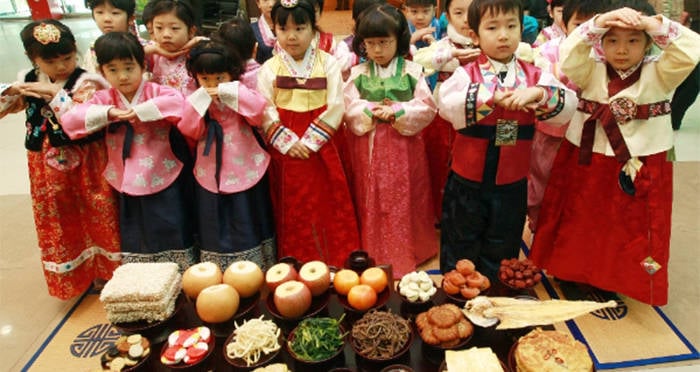

:max_bytes(150000):strip_icc()/zum-erntedankfest-unser-t-glich-brot-1047561166-5c7408df46e0fb0001436273.jpg)
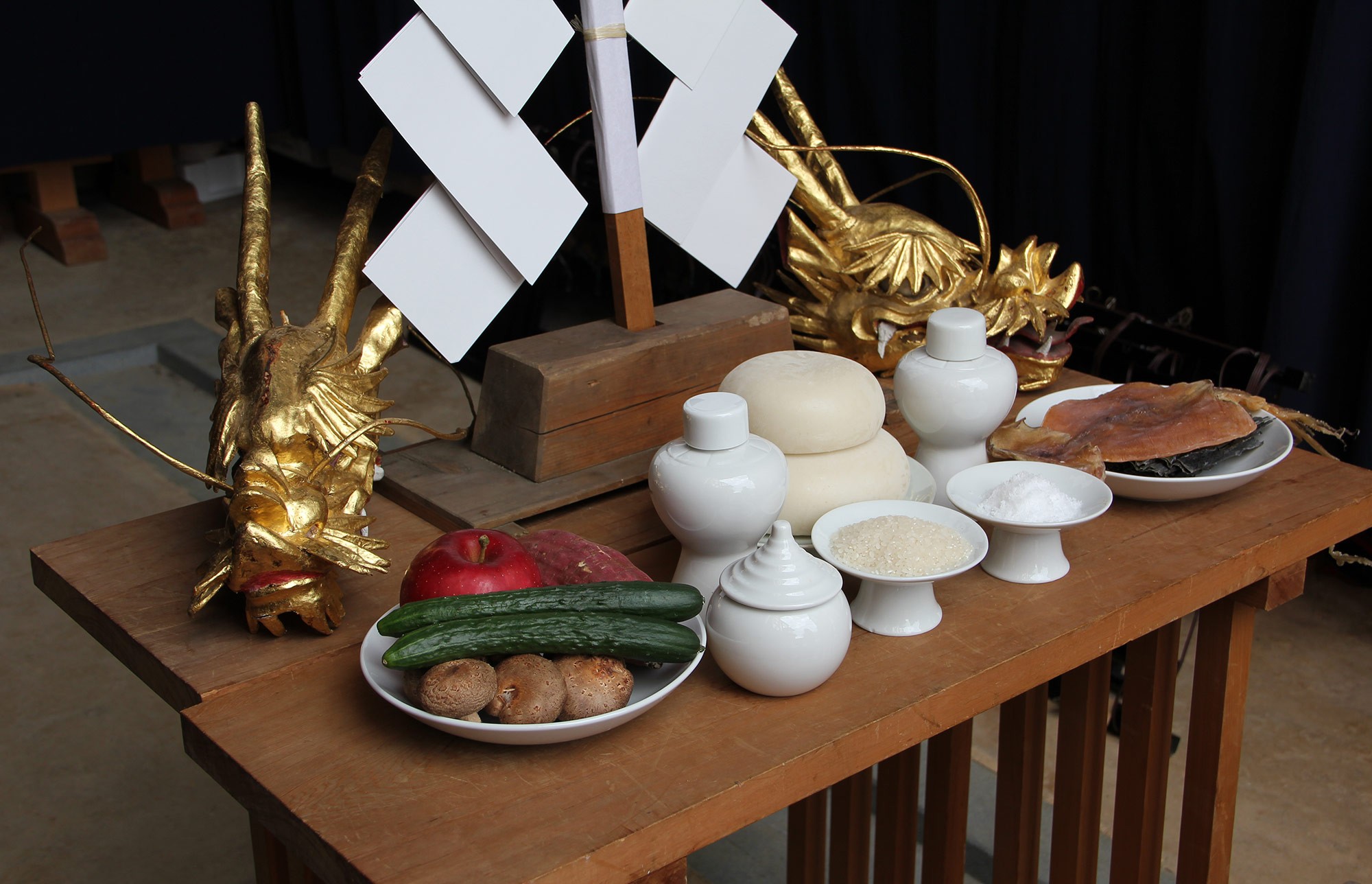




The Heart of Thanksgiving | How Faith Fuels a Life of Gratitude
“You will be enriched in every way so that you can be generous on every occasion, and through us your generosity will result in thanksgiving to God.” – 2 Corinthians 9:11
Gratitude lies at the heart of many of the world’s spiritual traditions, viewed as a transformative practice that deepens our connection to the divine and enriches our experience of life. Across Christianity, Islam, Buddhism, Native American spirituality, Hinduism, and Judaism, the practice of gratitude is seen not only as an expression of thankfulness but as a path to spiritual growth, mindfulness, and inner peace. In Christianity, gratitude is woven into prayer and worship, acknowledging God’s blessings and fostering a humble heart. Islam emphasizes daily expressions of gratitude in prayer, reminding followers to appreciate life’s gifts and to seek contentment.
Buddhism teaches gratitude as a practice of mindfulness, helping individuals appreciate the present moment and the interconnectedness of all beings. Native American spirituality honors gratitude as a way of living in harmony with nature and showing reverence for the earth’s gifts. Hinduism integrates gratitude through daily rituals and offerings, where every act of devotion is a recognition of divine abundance. Judaism emphasizes giving thanks to God in every aspect of life, with gratitude seen as a way to honor one’s blessings and strengthen communal bonds. Through these diverse perspectives, we can see how gratitude is not only a practice but a guiding principle that aligns us with higher truths and enriches our lives.
Christianity: Christianity emphasizes the practice of giving thanks in all circumstances as a way of aligning with the divine will. Gratitude is seen as an expression of faith and acknowledgment of God’s goodness.

Islam: Islam encourages gratitude as a means of receiving more blessings from God. Gratefulness is viewed as a form of worship and a way to avoid ingratitude, which may lead to divine consequences.

Buddhism: In Buddhism, mindfulness and awareness are key elements. Cultivating gratitude is seen as a practice that brings attention to the present moment. Gratefulness helps individuals recognize the interconnectedness of all life and fosters a sense of contentment.

Hinduism: Hinduism emphasizes gratitude as a practice for gaining wisdom and self-knowledge. Gratitude is not limited to those who have helped but extends to those who may have presented challenges, contributing to personal growth.

For Hindus, gratitude is woven into daily life and rituals, from feeding animals at dawn to offering food to deities before meals. Every Hindu festival centers on counting blessings and giving thanks, making Thanksgiving’s spirit of gratitude familiar.
Judaism: Gratitude is an essential aspect of Jewish teachings. Giving thanks to God is viewed as a righteous and joyful act. Gratitude is expressed through prayers, blessings, and the acknowledgment of God’s benevolence.
Thanksgiving may have roots in the Jewish holiday of Sukkot, as many believe the Pilgrims used Sukkot as a model for their fall harvest celebration. Today, Jewish ideas and rituals can easily be incorporated into Thanksgiving traditions, enhancing its meaning.
Native American: Many Native American traditions emphasize gratitude for the earth, its resources, and all living beings. Practices such as ceremonies and rituals are centered around expressing thanks to the natural world and acknowledging the interconnectedness of all life.

Mending Hearts | The Transformative Spirit of Thanksgiving Giving
“Let me always count my blessings. To be thankful for my family and friends. To be thankful for the simple things that life has to offer.” – Catherine Pulsifer
Thanksgiving serves as a meaningful occasion for reinforcing connections with both family and friends, creating an atmosphere of gratitude and togetherness. Shared meals, laughter, and expressions of thanks become the glue that binds families and friends together during this special time. Gathering with loved ones fosters a sense of belonging and strengthens the bonds that define familial and friendship relationships. The tradition of breaking bread together not only nourishes the body but also nourishes the soul, creating enduring memories and traditions that contribute to the rich tapestry of shared experiences.

















Mending Hearts | The Transformative Spirit of Thanksgiving Giving
“Each of us has a unique part to play in the healing of the world.” ― Marianne Williamson
Thanksgiving can be a meaningful time for healing old wounds within family and friend relationships. The holiday’s focus on gratitude, togetherness, and reflection provides an opportunity for individuals to set aside differences and resentments, choosing instead to appreciate the positive aspects of their relationships. Sharing a meal and spending time together can create a more relaxed and open atmosphere, fostering communication and understanding. It’s a chance to express gratitude for the positive qualities in each other, reflect on shared memories, and, in some cases, extend forgiveness. While it may not resolve all issues, Thanksgiving can serve as a stepping stone toward healing and rebuilding connections with family and friends.











“Be thankful for what you have. Your life is someone else’s fairy tale.” – Wale Ayeni David Thoreau


Travel



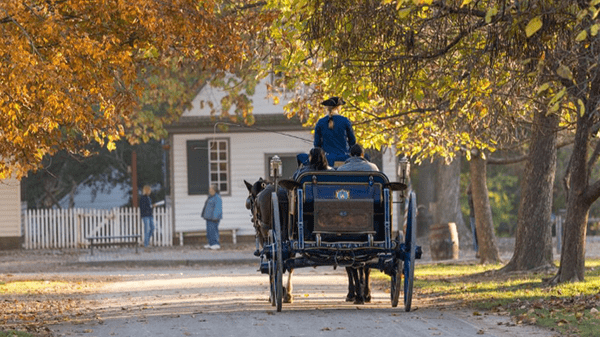

:max_bytes(150000):strip_icc()/GettyImages-1794830582-20bbcd58695d4a3f85776c6ed99bae40.jpg)


The Culinary Delights of Thanksgiving | A Feast for the Senses
“We can only be said to be alive in those moments when our hearts are conscious of our treasures.” – Thorton Wilder
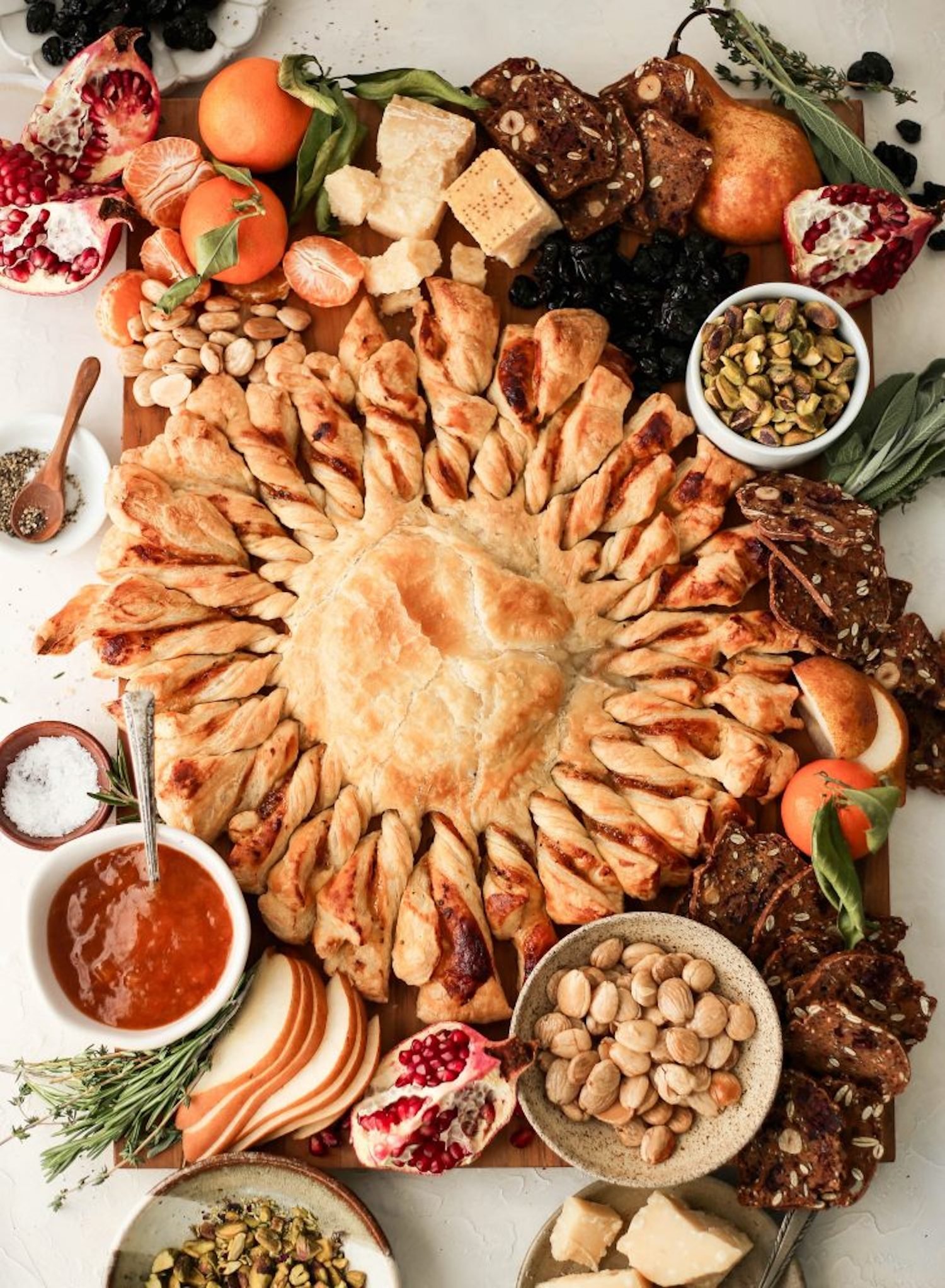

:max_bytes(150000):strip_icc()/Sweet_Potato_Casserole_012-645181ab4cab4adba3bf043ee4994c54.jpg)




:max_bytes(150000):strip_icc()/traditional-herbed-roast-turkey-5451434_0-04a1f3fff0b7450d871f9d7045978638.jpg)



Elevating Thanksgiving Dinner | Healthy Substitutes for Timeless Classics
“Wear gratitude like a cloak, and it will feed every corner of your life.” – Rumi
As the holiday season approaches, the desire for a nutritious and wholesome Thanksgiving feast doesn’t mean sacrificing flavor or tradition. Embracing a health-conscious approach to your holiday meal opens the door to a variety of creative and delicious alternatives. Consider swapping out the usual mashed potatoes for a flavorful cauliflower mash, which not only brings a delightful twist but also reduces the calorie load. Opting for whole grain or gluten-free alternatives in stuffing recipes introduces a hearty and fiber-rich element, ensuring that the meal is both satisfying and healthful. Additionally, embracing plant-based protein sources such as lentils or mushrooms provides an excellent alternative for those looking to reduce their meat consumption without compromising on taste.
Furthermore, there’s no need to forgo the classic pumpkin pie for dessert when healthier alternatives can be just as indulgent. Experimenting with recipes that incorporate natural sweeteners, like maple syrup or honey, and whole grain or nut crusts adds a nutritional boost to this beloved treat. Incorporating fresh, seasonal fruits into desserts can also elevate their nutritional profile while maintaining the festive spirit. By exploring these healthy substitutes, Thanksgiving dinner can become a celebration of both tradition and well-being, allowing everyone around the table to savor the flavors guilt-free and enjoy a nourishing holiday experience.







Creating a Cozy Thanksgiving Home | Decor Ideas to Welcome Family and Friends
“When one has a grateful heart, life is so beautiful.” – Roy T. Bennett
Decorating for Thanksgiving is a wonderful way to set the stage for a warm and welcoming celebration. A few thoughtful touches can turn any home into a cozy retreat where friends and family feel embraced by the holiday spirit. Start with a festive centerpiece—think pumpkins, gourds, autumn leaves, or candles—to bring a touch of nature to your table. Layer in cozy textures with throw blankets and pillows in earthy tones, adding warmth and comfort to your living spaces. Consider a wreath or garland made from seasonal elements like pinecones, acorns, or eucalyptus to create a beautiful entryway. For a final touch, use subtle lighting like string lights or lanterns to add a soft glow, creating a relaxing ambiance that invites everyone to gather, reflect, and enjoy each other’s company. With a little creativity, these decorations not only make your home look festive but also add to the feeling of gratitude and togetherness that Thanksgiving inspires.





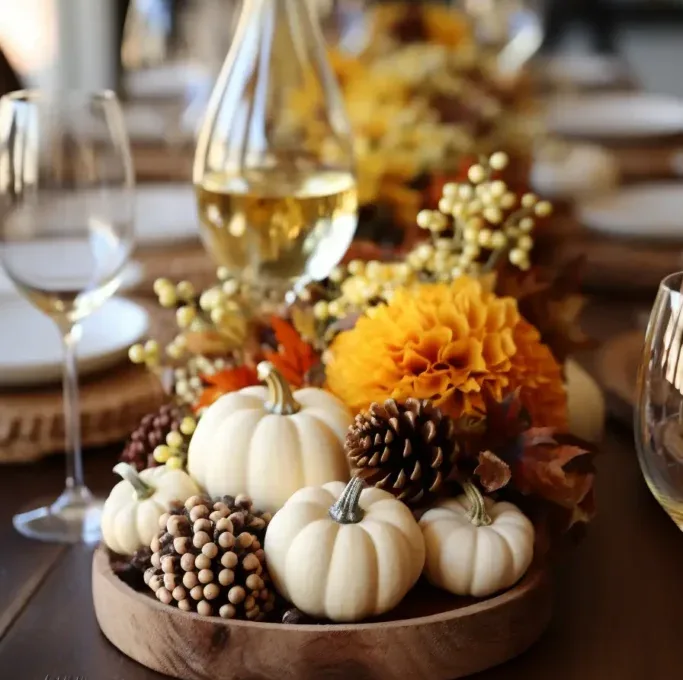








Thanksgiving, Mindfulness and Practicing Gratitude | Finding the Divine in Daily Life
“The present moment is filled with joy and happiness. If you are attentive, you will see it.” – Thich Nhat Hanh
Thanksgiving and mindfulness seamlessly converge in a shared pursuit of cultivating awareness, practicing gratitude, and appreciation for the present moment. The principles of mindfulness offer a transformative guide for individuals seeking to discover the divine in their daily lives, particularly during the Thanksgiving season. Mindfulness invites a profound presence during acts of gratitude, emphasizing the importance of savoring and fully experiencing each moment to establish a deeper connection with the divine.
Thanksgiving, with its sensory richness, becomes an opportunity for mindful engagement, prompting individuals to appreciate the divine in the simple joys of taste, touch, smell, sight, and sound. Practicing gratitude is an integral part of this mindfulness journey, aligning with mindfulness principles by focusing on the positive aspects of life and nurturing a thankful heart. Mindful awareness further enhances the quality of relationships during Thanksgiving gatherings, fostering deeper connections through intentional listening and appreciation of shared moments.
From mindful eating during Thanksgiving meals to expressing thanks for nature’s bounty and cultivating gratitude through rituals, mindfulness becomes a guiding thread, creating a sacred space for connecting with the divine. The recognition of joy in simple moments, silent reflection, and prayer all contribute to a mindful connection with the divine during Thanksgiving activities. Beyond the day of celebration, mindfulness extends into post-Thanksgiving reflections, allowing individuals to carry the spirit of gratitude into their daily lives. By infusing Thanksgiving with the spirit of mindfulness, individuals deepen their awareness of the divine in everyday experiences, fostering gratitude, connection, and reverence for the present moment and the blessings it holds.



:max_bytes(150000):strip_icc()/how-to-practice-gratitude-this-thanksgiving-5086515-ADD-FINAL-V2-bbb05f8ac0e6421ab65d93d79fb5c202.png)








Some of the most admired people in the world had to endure tremendous hardship for a season of their life, or, in some cases, the majority of their adult life.

The Power of Prayerful Thanks | Expressing Thanks Through Rituals and Prayer
“Thanks be to God for His indescribable gift!” – 2 Corinthians 9:15
Expressing thanks through rituals and prayer is a profound and meaningful way to convey gratitude, providing a structured and intentional means of acknowledging the divine and fostering a deep sense of connection. Rituals such as Thanksgiving grace, where individuals express thanks before a meal, or gratitude journaling, a ritual of writing down things for which one is thankful, become powerful avenues for cultivating gratitude. Establishing routines of morning and evening prayers allows individuals to begin and end their days with expressions of gratitude for the gift of life and opportunities for growth. Seasonal thankfulness rituals, gratitude circles or sharing sessions in communal settings, and rituals like creating a sacred space with symbols of gratitude contribute to a collective energy of appreciation. Whether through a Thanksgiving Tree or Jar, where notes of thanks are added throughout the year, or gratitude meditation focusing on blessings, these practices deepen the connection with the divine and create a sacred space for reflection and appreciation. acts of service as rituals of thanks extend beyond words, while fasting and Thanksgiving combine spiritual discipline with expressions of gratitude. Festive celebrations, such as Thanksgiving or religious holidays, often involve prayer rituals, emphasizing the importance of gratitude in these communal celebrations. Integrating these rituals into daily life becomes a meaningful and intentional expression of thanks, fostering a sense of gratitude and connection with the divine.


:max_bytes(150000):strip_icc()/thanksgiving-prayer-gettyimages-1095427770-2000-8153be1fe4bb4fc895aa9dd8be8e4e30.jpg)




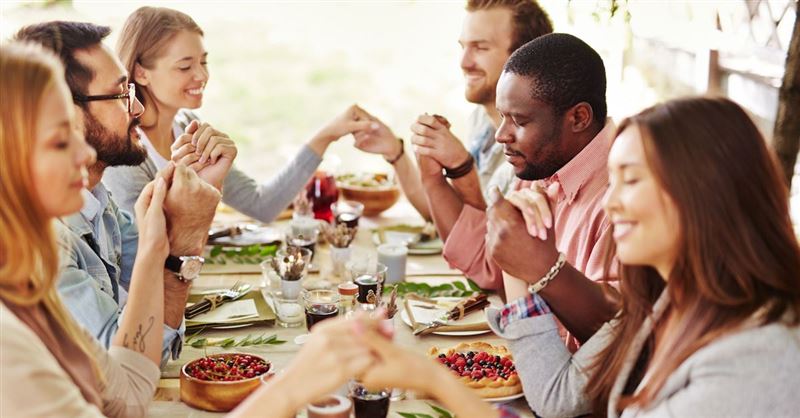



Exploring Spiritual Perspectives | The Transformative Power of Gratitude
“Be consistent in your dedication to showing your gratitude to others. Gratitude is a fuel, a medicine and spiritual and emotional nourishment.” – Steve Maraboli
Gratitude, as a transformative force, profoundly nourishes the soul, instigating positive changes in individuals’ lives. This transformative power operates through key mechanisms, including a significant shift in perspective towards abundance, fostering joy and contentment. Gratitude becomes a cornerstone for emotional resilience, providing strength amidst life’s challenges and connecting individuals to inner peace, cultivating calm within their souls. Moreover, it prompts self-reflection, encouraging heightened self-awareness, recognition of values, and priorities. This practice fosters compassion and empathy, releasing negativity and allowing individuals to let go of burdens. Gratitude, intertwined with mindfulness, enriches each moment, promoting a deeper connection with the soul and cultivating humility by acknowledging interconnectedness and the contributions of others.
The sacred art of thankfulness and gratitude, deeply rooted in spiritual perspectives, is a profound exploration. It unfolds within a spiritual tapestry, emphasizing surrender, acceptance, and trust in divine order. Recognition of divine timing is central, fostering patience and acceptance. Gratitude acknowledges that all blessings come from a divine source, creating a conscious awareness of abundance through divine grace. Living in alignment with spiritual principles, abundant gratitude emphasizes being present in the moment and appreciating its richness. It extends beyond a mere expression of thanks, involving recognizing and acknowledging divine blessings. Gratitude in a spiritual context highlights interconnectedness, unity, and humility, fostering a transformative force that shifts consciousness, elevates the spirit, and radiates positive energy. Even in adversity, expressing gratitude is seen as an act of faith, trusting in life’s wisdom and purpose. Rituals and ceremonies centered around thanksgiving provide sacred spaces to express gratitude, creating a cycle of positive energy and divine grace. The sacred art of thankfulness, rooted in spiritual perspectives, transcends mere appreciation; it becomes a profound way of relating to the divine and fostering a heart-centered approach to spiritual living.









Thanksgiving Reflections | Insights From Spiritual Teachers
“Acknowledging the good that you already have in your life is the foundation for all abundance.” – Eckhart Tolle
Drawing inspiration from the profound teachings of spiritual leaders, Thanksgiving reflections delve into themes of gratitude, mindfulness, compassion, and interconnectedness. Here are poignant lessons to ponder, enriched by the wisdom of spiritual teachers:
- Gratitude as a Transformative Force: “Gratitude can transform common days into thanksgivings, turn routine jobs into joy, and change ordinary opportunities into blessings.” – William Arthur Ward
- Mindful Presence in the Moment: “The present moment is filled with joy and happiness. If you are attentive, you will see it.” – Thich Nhat Hanh
- Recognizing the Sacred in Everyday Life: “We need to find God, and he cannot be found in noise and restlessness. God is the friend of silence.” – Mother Teresa
- Cultivating a Heart of Compassion: “Our prime purpose in this life is to help others. And if you can’t help them, at least don’t hurt them.” – Dalai Lama
- Appreciation for Abundance: “When you arise in the morning, give thanks for the morning light, for your life and strength. Give thanks for your food and the joy of living. If you see no reason for giving thanks, the fault lies in yourself.” – Tecumseh
- Acts of Service and Generosity: “The best way to find yourself is to lose yourself in the service of others.” – Mahatma Gandhi
- Fostering Inner Peace: “Peace comes from within. Do not seek it without.” – Buddha
- A Time for Forgiveness: “Forgiveness is not always easy. At times, it feels more painful than the wound we suffered, to forgive the one that inflicted it. And yet, there is no peace without forgiveness.” – Marianne Williamson
In essence, these Thanksgiving reflections, influenced by the profound insights of spiritual leaders, emphasize the transformative power of gratitude, the importance of mindful presence, and the practice of forgiveness. These teachings contribute to a deeper and more meaningful experience of the holiday, encouraging reflection on the essence of Thanksgiving beyond its traditional festivities.








Embracing Gratitude | A Spiritual Journey on Thanksgiving
“Gratitude is when memory is stored in the heart and not in the mind.” – Lionel Hampton
Embracing gratitude becomes a profound spiritual journey on Thanksgiving, transcending the customary festivities to delve into the deeper dimensions of the soul. It is a time when hearts, attuned to the spirit of thankfulness, embark on a reflective pilgrimage. As individuals gather with loved ones, the air becomes charged with a sense of reverence, and gratitude takes center stage as a transformative force. This spiritual journey involves cultivating mindfulness, recognizing the interconnectedness of all existence, and acknowledging the divine source from which blessings flow. Thanksgiving becomes a sacred tapestry woven with threads of appreciation for the present moment, an earnest expression of thanks for the abundance of life’s blessings, and a humble surrender to the mysteries of existence. In the embrace of gratitude, individuals find solace, joy, and a harmonious connection with the sacred essence that permeates every facet of their lives. The spiritual journey of Thanksgiving invites a contemplative pause, fostering a deeper understanding of the grace inherent in gratitude and the profound wisdom it imparts to those who embark on this sacred journey of the heart.









Quotes of Thanks | Celebrating the Spirit of Thanksgiving Through Inspirational Words
“Reflect upon your present blessings, of which every man has plenty; not on your past misfortunes, of which all men have some.” – Charles Dickens
As Thanksgiving draws near, the season of gratitude comes alive through a collection of heartfelt quotes that beautifully encapsulate the spirit of giving thanks. These timeless words act as gentle reminders to pause, reflect, and embrace the abundance in our lives. From profound meditations on gratitude’s transformative power to cheerful expressions of appreciation, these quotes weave together a universal celebration of life’s blessings, speaking to hearts across generations and cultures.
- “As we express our gratitude, we must never forget that the highest appreciation is not to utter words, but to live by them.” – John F. Kennedy
- “Feeling gratitude and not expressing it is like wrapping a present and not giving it.” – William Arthur Ward
- “Gratitude unlocks the fullness of life.” – Melody Beattie
- “Gratitude builds a bridge to abundance.” – Roy T. Bennett
- “Gratitude is the inward feeling of kindness received. Thankfulness is the natural impulse to express that feeling. Thanksgiving is the following of that impulse.” – Henry Van Dyke
- “Gratitude is the closest thing to beauty manifested in an emotion.” – Mindy Kaling
- “Gratitude can transform common days into thanksgivings, turn routine jobs into joy, and change ordinary opportunities into blessings.” — William Arthur Ward
- “I am grateful for what I am and have. My thanksgiving is perpetual.” – Henry David Thoreau
- “If the only prayer you ever say in your entire life is thank you, it will be enough.” – Meister Eckhart
- “In the end, maybe we must all give up trying to pay back the people in this world who sustain our lives. In the end, maybe it’s wiser to surrender before the miraculous scope of human generosity and to just keep saying thank you, forever and sincerely, for as long as we have voices.” – Elizabeth Gilber
- “Let gratitude be the pillow upon which you kneel to say your nightly prayer.”—Maya Angelou
- “Let us be grateful to people who make us happy; they are the charming gardeners who make our souls blossom.” – Marcel Proust
- “No one has ever become poor by giving.” – Anne Frank
- “Not what we say about our blessings, but how we use them, is the true measure of our thanksgiving.” – W.T. Purkiser
- “Someone I loved once gave me a box full of darkness. It took me years to understand that this, too, was a gift.” – Mary Oliver
- “Some people are always grumbling because roses have thorns; I am thankful that thorns have roses.” – Alphonse Karr
- “Showing gratitude is one of the simplest yet most powerful things humans can do for each other.” – Randy Pausch
- “Thankfulness is the quickest path to joy.” — Jefferson Bethke
- “Thanksgiving is a joyous invitation to shower the world with love and gratitude.” – Amy Leigh Mercree
- “Thanksgiving is a time of togetherness and gratitude.” – Nigel Hamilton
- “The more you practice the art of thankfulness, the more you have to be thankful for.” – Norman Vincent Peale
- “The real gift of gratitude is that the more grateful you are, the more present you become.” – Robert Holden
- “To speak gratitude is courteous and pleasant, to enact gratitude is generous and noble, but to live gratitude is to touch Heaven.” – Johannes A. Gaertner
- “The unthankful heart discovers no mercies; but the thankful heart will find, in every hour, some heavenly blessings.” – Henry Ward Beecher
- “We must find the time to stop and thank the people who make a difference in our lives.” – John F. Kennedy
- “We should certainly count our blessings, but we should also make our blessings count.” – Neal A. Maxwell
- “When I started counting my blessings, my whole life turned around.” – Willie Nelson
- “When we give cheerfully and accept gratefully, everyone is blessed.” – Maya Angelou
- “When one has a grateful heart, life is so beautiful.” – Roy T. Bennett



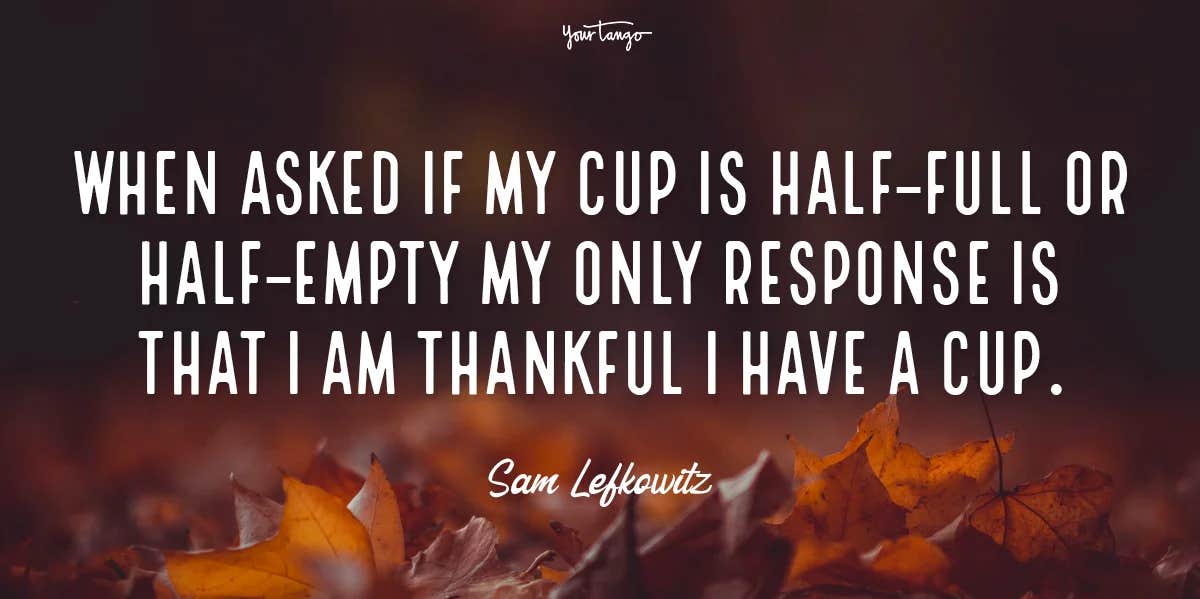
The 3 C’s of Life: “Choices, Chances, and Changes”,
You must make a choice to take a chance or your life will never change. – Zig Ziglar

“You can’t go back and change the beginning, but you can start where you are and change the ending.” – CS Lewis
We offer both Personal Coaching and Consulting for executives and businesses owners. Providing guidance, intelligence briefings and strategic planning to navigate the dynamic changes and shifts in the world.
Share This Report
Have questions?
At Great Awakening Report, we are dedicated to supporting your journey toward truth and enlightenment through our specialized Coaching and Consulting services.
Coaching Services: Our coaching programs are designed to guide you through personal awakening and transformation. We offer personalized sessions that focus on expanding consciousness, uncovering hidden truths, and fostering spiritual growth. Our experienced coaches provide the tools and insights necessary to navigate your path with clarity and confidence.
Consulting Services: For organizations and individuals seeking deeper understanding and strategic guidance, our consulting services offer expert analysis and solutions. We delve into areas such as global transitions, alternative news insights, and consciousness studies to provide comprehensive strategies tailored to your unique objectives.
Embark on a transformative journey with our Coaching and Consulting services, and unlock your highest potential. To learn more and schedule a session, visit our Coaching and Consulting pages.
Thank you
Thank you to our subscribers and readers for your continued support and dedication to truth and awakening. Your encouragement, engagement, and belief in our mission make everything we do possible. Together, we are expanding awareness and helping illuminate the path forward.
If you would like to further support the Great Awakening team and our ongoing efforts to share insight, knowledge, and truth, you can DONATE HERE.
With deep gratitude,
– Great Awakening Team
DISCLAIMER: All statements, claims, views and opinions that appear anywhere on this site, whether stated as theories or absolute facts, are always presented by The Great Awakening Report (GAR) as unverified—and should be personally fact checked and discerned by you, the reader.Any opinions or statements herein presented are not necessarily promoted, endorsed, or agreed to by GAR, those who work with GAR, or those who read or subscribe to GAR.Any belief or conclusion gleaned from content on this site is solely the responsibility of you the reader to substantiate.Any actions taken by those who read material on this site are solely the responsibility of the acting party.You are encouraged to think for yourself and do your own research.Nothing on this site is meant to be believed without question or personal appraisal.
COPYRIGHT DISCLAIMER: Citation of articles and authors in this report does not imply ownership. Works and images presented here fall under Fair Use Section 107 and are used for commentary on globally significant newsworthy events. Under Section 107 of the Copyright Act 1976, allowance is made for fair use for purposes such as criticism, comment, news reporting, teaching, scholarship, and research.
COMMUNITY GUIDELINES DISCLAIMER: The points of view and purpose of this video is not to bully or harass anybody, but rather share that opinion and thoughts with other like-minded individuals curious about the subject.



.jpg)
















